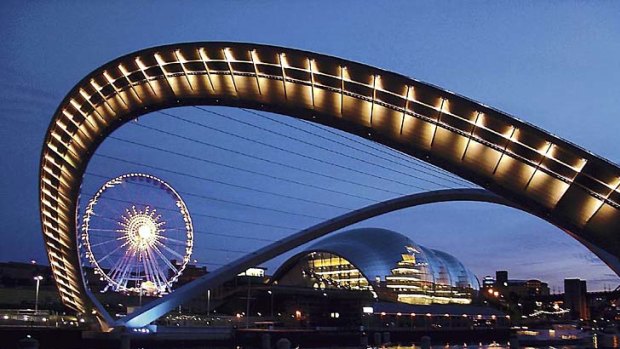This was published 12 years ago
From industrial wasteland to party central

Party central ... Newcastle has been named one of Europe's best cities for nightlife.Credit: Getty Images
Craig Platt discovers a surprising city enjoying a resurgence.
When you think about Europe's top towns for nightlife, dozens of names spring to mind: Paris, Barcelona, Berlin, Amsterdam, Prague, Manchester.
One name that doesn't spring to mind, at least to Australians, is Newcastle-upon-Tyne. And yet, the world's most popular travel site, TripAdvisor, has named the city in England's north as the third-best in Europe for nightlife - ahead of such places as Paris and Barcelona.
In Australia, the city is little-known beyond its reputation as a former centre of coal mining and heavy industry, decimated in the '80s by the policies of then-prime minister Margaret Thatcher and in decline ever since.
No longer. Newcastle is enjoying a resurgence, centred around culture and tourism. And it is attracting people. The city's population had been shrinking every year since the mining industry collapse in the '80s. But in the past few years, it has begun growing again.
My first indication that the city's reputation was not unfounded came as I caught the train up from London. I chatted to a fellow passenger about what I was doing in the UK and where I was headed.
A funtastic city fer a gret nart owt.
“Newcastle?” he said in a thick northern accent, “thut's a funtastic city fer a gret nart owt.”
Though headed there himself, he wasn't simply being parochial – he wasn't actually from Newcastle.
Upon arriving in at the grand Central Station, I'm immediately struck by the imposing classical architecture of Newcastle's city centre. These historic buildings have been restored over the last two decades from the blackened, grimy facades of the coal era to be given new life and often new purposes as restaurants, galleries and bars.

The Millennium Bridge with the Sage in the background.
Along the riverfront, the contrast between the restored historic buildings and the sleek, iconic erections of the modern city are apparent. Newcastle is actually part of a twin city, with Newcastle located north of the river Tyne and Gateshead on the south (brochures now refer to the city as 'NewcastleGateshead' and invite comparisons to Budapest).
Seven bridges connect the two sides of the city, including the Tyne Bridge (looking like a smaller version of our own iconic arch over Sydney Harbour) and the most recent Millennium Bridge (opened in 2001) – a pedestrian walkway that rotates on an axis to swing itself out of the way of watercraft.
Along the south bank of the river is where many of the newer architectural additions to the city can be seen. The enormous, mirrored Sage Gateshead concert hall is a striking building, its shell-like exterior containing three separate performance spaces.
Nearby is the Baltic Centre for Contemporary Art, a huge, multi-storied modern art gallery. Formerly a flour mill that closed back in 1981, it finally reopened in its current incarnation in 2002.
It's this mix of the modern with the historical that makes Newcastle such a fascinating place to stroll around.
In the centre of town sits the city's ancient Castle Keep. To the locals, it may well seem mundane, but to an Australian, its presence is mind blowing. Here in the heart of a bustling city sits an ancient castle built more than 800 years ago. Prior to that it was home to a Roman fort, later replaced by one built by the son of William the Conqueror – which was, in fact, the literal 'new castle' that gives the city its name.
Its third incarnation survives today, despite an act of “Victorian vandalism” (as a tour guide terms it) that saw a section knocked down so a railway line could be put through. Now, you can stand inside the ancient passageways and watch through the arrowslits as modern trains roll past.
But what of that famous nightlife? Already, in the late afternoon, I begin to spot groups of young men and women kicking off their evening. The city's reputation for great pubs has seen it become a popular spot for buck's and hen's night parties. Much of the action is centred around the Quayside area, where it's never more than a short stagger between pubs.
Instead of battling through the Friday-night throng I opt instead to head for The Cluny, a rock venue near my hotel, which is also heaving with punters in the early evening, many spilling out on the to street and the grassy embankment next to the venue. I enjoy a couple of pints from the pub's extensive range of beers and note that seminal pre-punk rockers the New York Dolls played the venue just a week earlier.
But I'm still jetlagged and travelling solo, so opt to call it a night even as the venue's party atmosphere begins to get going.
My taste of Newcastle's legendary nightlife has been brief, but it turns out to be just one of the surprising aspects of this revitalised northern city.
The writer travelled as a guest of Visit Bri-tain and AirAsia X.
Three other things to do
1. Newcastle is home to two excellent and diverse museums. The Discovery Museum pays tribute to the city's strong history of engineering innovation and is chock-full of boys' toys including the world's first steam-turbine powered ship, the Turbinia, which became the world's fastest ship upon its launch in the late 1800s and change the shape of naval transport. See http://www.twmuseums.org.uk/discovery/
2. The seaside village of Tynemouth is a short train ride away from the city and home to the spectacular Tynemouth Priory and Castle – the ruins of an ancient building located on a dramatic headland at the entrance of the river Tyne. It's an excellent place to explore for a day or overnight trip. For more details on the Priory, visit http://www.english-heritage.org.uk/daysout/properties/tynemouth-priory-and-castle/
3. The Baltic Centre of Contemporary Art houses five galleries and offers a regularly changing program of contemporary art. It's rooftop restaurant and viewing terrace both offer excellent views of the river and city (as well as being the best place in town to watch the Millennium Bridge swing). See http://www.balticmill.com
Fast facts
Getting there
AirAsia X flies daily to London via Kuala Lumpur from Melbourne, the Gold Coast and Perth. See www.airasia.com
Britain's National Rail Network has trains approximately every 30 minutes between London's Kings Cross Station and Newcastle Central (about three hours' travel time). Foreign visitors can book a Britrail pass, providing access to all trains in England, Scotland and Wales. Prices start from $225 for a three-day pass. See www.britrail.com
Staying there
Hotel du Vin is located on the banks of the River Tyne, a short walk from the Millennium Bridge, Sage Gateshead and Baltic. See http://www.hotelduvin.com/hotels/newcastle/newcastle.aspx
In Tyneside, Front Street is home to many B&Bs. The Martineau Guest House is a cosy B&B five minutes' walk from the Priory and Castle (the guest house is named for former resident Harriet Martineau, England's first female journalist). See www.martineau-house.co.uk
More information
See http://www.newcastlegateshead.com
Follow Traveller on Twitter @FairfaxTravel
Sign up for the Traveller Deals newsletter
Get exclusive travel deals delivered straight to your inbox. Sign up now.